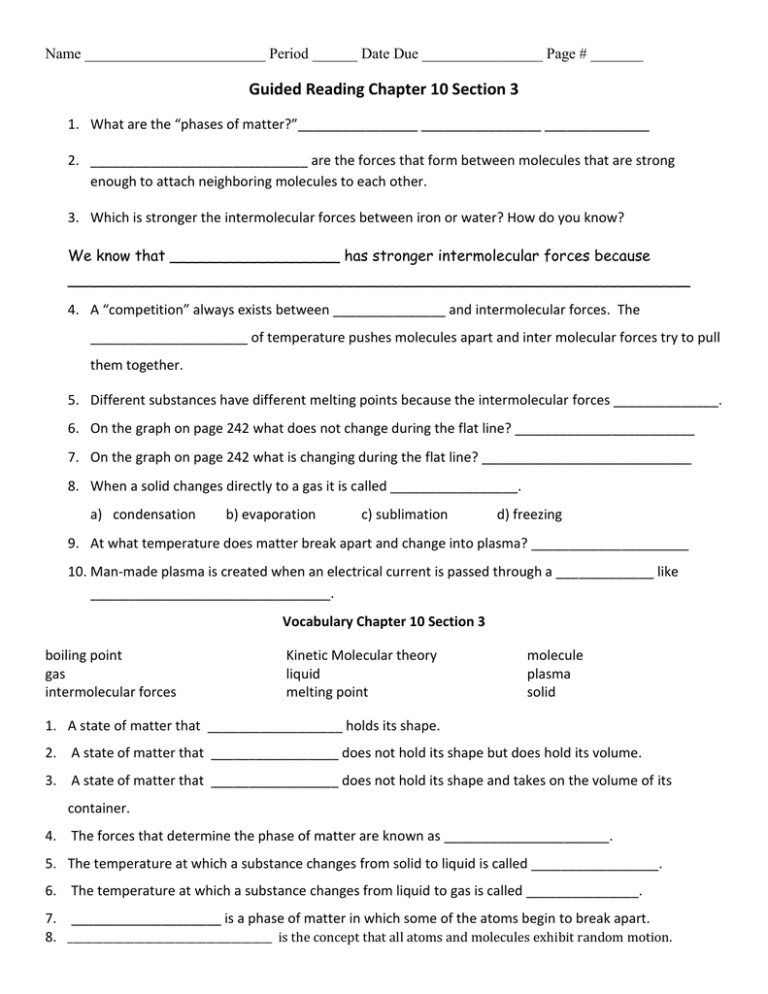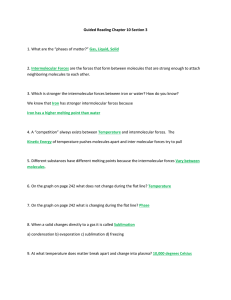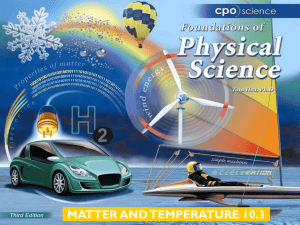Guided Reading Chapter 10 Section 3
advertisement

Name ________________________ Period ______ Date Due ________________ Page # _______ Guided Reading Chapter 10 Section 3 1. What are the “phases of matter?”________________ ________________ ______________ 2. _____________________________ are the forces that form between molecules that are strong enough to attach neighboring molecules to each other. 3. Which is stronger the intermolecular forces between iron or water? How do you know? We know that __________________ has stronger intermolecular forces because __________________________________________________________________ 4. A “competition” always exists between _______________ and intermolecular forces. The _____________________ of temperature pushes molecules apart and inter molecular forces try to pull them together. 5. Different substances have different melting points because the intermolecular forces ______________. 6. On the graph on page 242 what does not change during the flat line? ________________________ 7. On the graph on page 242 what is changing during the flat line? ____________________________ 8. When a solid changes directly to a gas it is called _________________. a) condensation b) evaporation c) sublimation d) freezing 9. At what temperature does matter break apart and change into plasma? _____________________ 10. Man-made plasma is created when an electrical current is passed through a _____________ like ________________________________. Vocabulary Chapter 10 Section 3 boiling point gas intermolecular forces Kinetic Molecular theory liquid melting point molecule plasma solid 1. A state of matter that __________________ holds its shape. 2. A state of matter that _________________ does not hold its shape but does hold its volume. 3. A state of matter that _________________ does not hold its shape and takes on the volume of its container. 4. The forces that determine the phase of matter are known as ______________________. 5. The temperature at which a substance changes from solid to liquid is called _________________. 6. The temperature at which a substance changes from liquid to gas is called _______________. 7. ____________________ is a phase of matter in which some of the atoms begin to break apart. 8. ________________________________________ is the concept that all atoms and molecules exhibit random motion. Name ________________________ Period ______ Date Due ________________ Page # _______ Section Review Chapter 10 Section 3 Complete the following table to demonstrate your knowledge of the different phases of matter. Phase Energy (movement of particles) Characteristics that you see Temperature (medium and low) Holds shape and doesn’t flow Solid Intermolecular Force (strong and weakest) Molecular Diagram (pg240) strongest Molecules move around Gas high Atoms break apart weak highest 1. Identify the phase or phases of matter (solids, liquids, and gases) that apply to each statement. More than one phase of matter may apply to each statement. (Plasma is used once) a. Molecules do not move around, but vibrate in place __________________ b. Has volume but no particular shape __________________ c. Flows __________________ __________________ d. Molecules break free of intermolecular forces __________________ e. Does not have a volume or shape__________________ f. Molecules can move around and switch places, but remain close together__________________ 2. Matter has four phases that we experience. List the four phases in order of increasing temperature (lowest to highest) 3. Put the following terms in order from greatest intermolecular forces, to weakest intermolecular forces: liquid, gas, solid. 4. Identify the segment of the graph (A, B, C, D, E) in Figure 10.17 where a phase change is occurring. There could be more than one place. Explain your reasoning.






